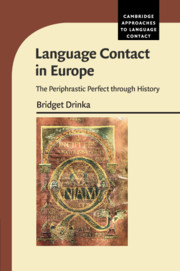Book contents
- Frontmatter
- Contents
- Series Editor's Foreword
- Acknowledgments
- Abbreviations, Based on the Leipzig Glossing Rules
- 1 Language Contact in Europe: The Periphrastic Perfect through History
- 2 Languages in Contact, Areal Linguistics, and the Perfect
- 3 The Perfect as a Category
- 4 Sources of the Perfect in Indo- European
- 5 The Periphrastic Perfect in Greek
- 6 The Periphrastic Perfect in Latin
- 7 The Charlemagne Sprachbund and the Periphrastic Perfects
- 8 The Core and Peripheral Features of the Romance Languages
- 9 The Early Development of the Perfect in the Germanic Languages
- 10 The Semantic Shift of Anterior to Preterite
- 11 The Balkan Perfects: Grammaticalization and Contact
- 12 Byzantium, Orthodoxy, and Old Church Slavonic
- 13 The l- perfect in North Slavic
- 14 Updating the Notion of Sprachbund: New Resultatives and the Circum- Baltic “Stratifi ed Convergence Zone”
- 15 The have Resultative in North Slavic and Baltic
- 16 Conclusions
- Notes
- Bibliography
- Index
14 - Updating the Notion of Sprachbund: New Resultatives and the Circum- Baltic “Stratifi ed Convergence Zone”
Published online by Cambridge University Press: 23 February 2017
- Frontmatter
- Contents
- Series Editor's Foreword
- Acknowledgments
- Abbreviations, Based on the Leipzig Glossing Rules
- 1 Language Contact in Europe: The Periphrastic Perfect through History
- 2 Languages in Contact, Areal Linguistics, and the Perfect
- 3 The Perfect as a Category
- 4 Sources of the Perfect in Indo- European
- 5 The Periphrastic Perfect in Greek
- 6 The Periphrastic Perfect in Latin
- 7 The Charlemagne Sprachbund and the Periphrastic Perfects
- 8 The Core and Peripheral Features of the Romance Languages
- 9 The Early Development of the Perfect in the Germanic Languages
- 10 The Semantic Shift of Anterior to Preterite
- 11 The Balkan Perfects: Grammaticalization and Contact
- 12 Byzantium, Orthodoxy, and Old Church Slavonic
- 13 The l- perfect in North Slavic
- 14 Updating the Notion of Sprachbund: New Resultatives and the Circum- Baltic “Stratifi ed Convergence Zone”
- 15 The have Resultative in North Slavic and Baltic
- 16 Conclusions
- Notes
- Bibliography
- Index
Summary
Chapter 13 focused on Maslov's second layer, the distribution of the l-perfect in N. Slavic, the loss of anterior meaning, and the development of preterital value for this construction across the N. Slavic languages. In the next two chapters, we turn our attention to Maslov's third layer, exploring the introduction of new periphrastic perfects and resultatives in *ṷes- or *–n/t- in the N. Slavic and Baltic languages. The present chapter begins with an overview of the distribution of these structures, and proceeds to an examination of the role of contact in the development of each. With regard specifically to the Circum-Baltic region, we follow Stolz (1991), Nau (1996), and Koptjevskaja-Tamm and Wälchli (2001) in endorsing the modification of the concept of Sprachbund for this area; what is envisioned here instead is the notion of a “Stratified Convergence Zone,” a three-dimensional model depicting layers of contact across space and time. Evidence from the new resultatives of Baltic and N. Slavic, especially in the Circum-Baltic area, strongly supports the validity of this proposal: both the *ṷes- and the *–n/t- resultatives show signs of stratified development and diffusion at the micro- and macro-level.
The “New Resultatives” of North Slavic and Baltic
In their comprehensive study of the resultative structures of the N. Slavic and Baltic languages, Wiemer and Giger (2005) explore the present-day distribution of the periphrastic resultative structures, especially those constructed with participles in –n/t- or -(v)ši /-vęs, with an eye to areal spread and the effects of grammaticalization. We will make full use of their findings in this section as we attempt to sort out the historical foundations for the current, complex distribution of these structures.
As the l-perfects took on preterital value in virtually all the N. Slavic languages, other participial structures came to be used more productively to fill various functions, whether as subject-oriented resultatives, object-oriented resultatives, or possessive resultatives.
- Type
- Chapter
- Information
- Language Contact in EuropeThe Periphrastic Perfect through History, pp. 341 - 376Publisher: Cambridge University PressPrint publication year: 2017

